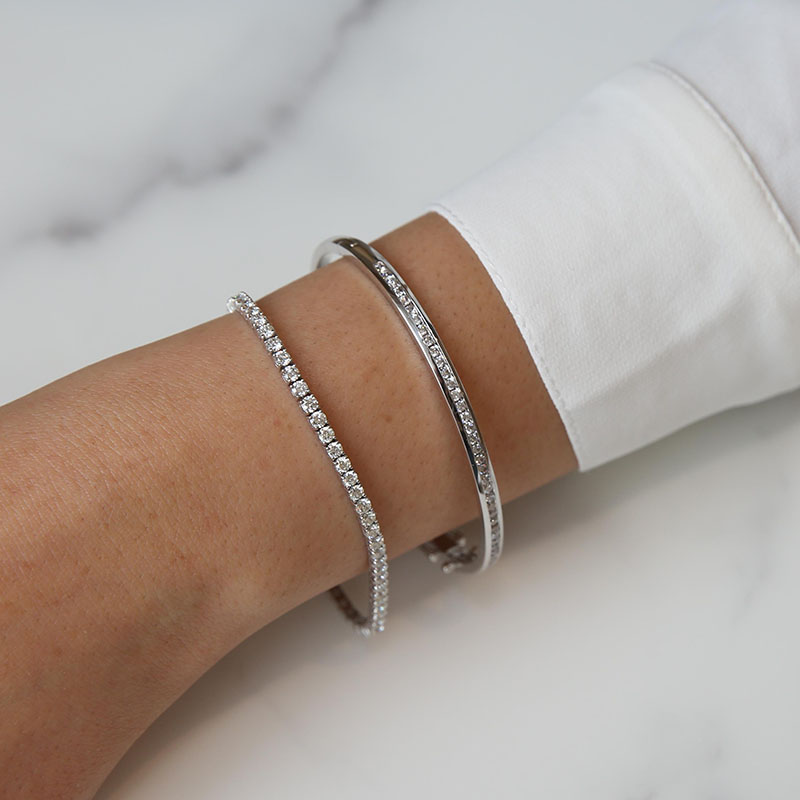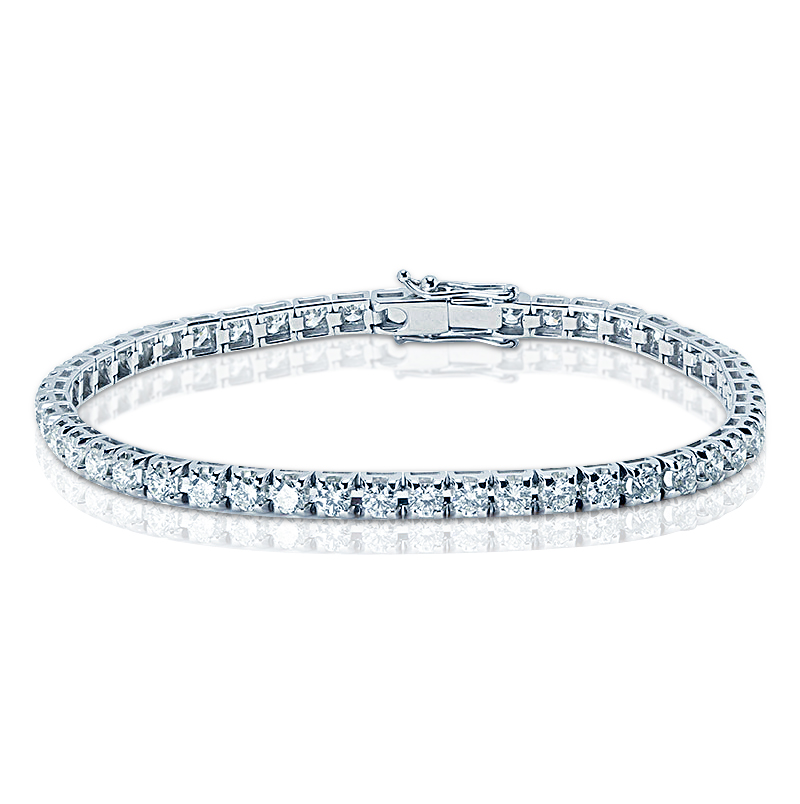In the realm of fine jewelry, few pieces capture the essence of timeless elegance and continuous sparkle quite like the diamond tennis bracelet. It’s a statement of sophistication, a whisper of luxury that wraps around the wrist, catching the light with every movement. Today, this iconic design is undergoing a fascinating evolution, driven by innovation and a growing consciousness among consumers. The emergence of lab-grown diamonds has opened new avenues for acquiring breathtaking jewelry, and perhaps nowhere is this more evident and impactful than with the 4 Carat Lab-Grown Diamond Tennis Bracelet.
This article delves into the captivating world of this modern classic, exploring what makes a 4-carat lab-grown diamond tennis bracelet an exceptional choice, from its ethical origins and stunning visual appeal to its remarkable value and enduring versatility.
A Legacy of Sparkle: The Tennis Bracelet’s Iconic Status
Before we explore the nuances of lab-grown diamonds, let’s appreciate the design itself. The tennis bracelet, characterized by a continuous, flexible line of individually set diamonds, has a storied history. Its enduring appeal skyrocketed in 1987 when professional tennis player Chris Evert famously paused a US Open match to retrieve her diamond bracelet that had fallen off. This incident, broadcast globally, immortalized the "tennis bracelet" as a symbol of effortless glamour and active luxury.
What sets a tennis bracelet apart is its inherent fluidity. Each diamond is typically set in a delicate metal link, allowing the bracelet to drape gracefully around the wrist, conforming to its shape and moving with the wearer. The goal is a seamless stream of light, an unbroken circle of brilliance that commands attention without being overtly ostentatious.
The Power of Four: Understanding "4 Carat" in a Bracelet
When we talk about a "4 carat" lab-grown diamond tennis bracelet, it’s crucial to understand that this refers to the Total Carat Weight (TCW) of all the diamonds combined, not the size of a single stone. A 4 TCW bracelet typically features numerous smaller diamonds, each meticulously matched for size, cut, color, and clarity, to create a harmonious and brilliant display.
The number of diamonds can vary depending on their individual size and the length of the bracelet. For instance, a standard 7-inch bracelet might feature anywhere from 40 to 60 individual diamonds, each weighing approximately 0.07 to 0.10 carats (7 to 10 points). This distribution allows for a substantial visual presence – a rich, vibrant band of sparkle – while maintaining the delicate and flexible nature of the design. A 4-carat TCW strikes a magnificent balance, offering significant sparkle and a luxurious feel without being overwhelmingly large, making it perfect for both everyday wear and special occasions.
Lab-Grown Diamonds: The Future of Brilliance
The "lab-grown" aspect is where the true revolution lies. Lab-grown diamonds are not imitations or simulants; they are real diamonds in every chemical, physical, and optical sense. They possess the exact same atomic structure (pure carbon in a cubic crystalline form) and exhibit the same dazzling fire, brilliance, and scintillation as their mined counterparts. The key difference lies in their origin: instead of forming deep within the Earth over billions of years, they are created in highly controlled laboratory environments using advanced technological processes.
There are two primary methods for growing diamonds in a lab:
- High-Pressure/High-Temperature (HPHT): This method replicates the natural diamond formation process by subjecting carbon to immense pressure and high temperatures.
- Chemical Vapor Deposition (CVD): This process involves placing a diamond seed in a vacuum chamber filled with carbon-rich gases. These gases break down, and the carbon atoms slowly adhere to the seed, crystallizing into a new diamond layer by layer.
Both methods yield genuine diamonds that are indistinguishable from mined diamonds without specialized equipment. They are graded by the same independent gemological laboratories (like GIA, IGI, GCAL) using the same stringent "4 Cs" criteria: Cut, Color, Clarity, and Carat.
Why Choose a Lab-Grown Diamond Tennis Bracelet? The Irresistible Advantages
The decision to opt for a 4 carat lab-grown diamond tennis bracelet comes with a compelling array of benefits that resonate with modern consumers:
-
Unparalleled Value: This is arguably the most significant advantage. Lab-grown diamonds typically offer a price point that is 30-50% (or even more) lower than equivalent mined diamonds. For a substantial 4-carat total weight, this cost saving is monumental, allowing you to acquire a much larger, higher-quality, or more intricate piece of jewelry within your budget. You can achieve a breathtaking level of brilliance and luxury that might otherwise be out of reach.
-
Ethical Assurance: Lab-grown diamonds are inherently conflict-free. Their origin is fully traceable and transparent, eliminating any concerns about unethical labor practices, funding of conflict, or environmental damage associated with some diamond mining operations. This peace of mind is invaluable for many buyers who prioritize responsible sourcing.
-
Environmental Responsibility: While diamond mining can have a significant environmental footprint (land disruption, energy consumption, water usage), lab-grown diamond production generally requires fewer natural resources and has a smaller carbon footprint. As technology advances, the environmental impact of lab-grown diamonds continues to decrease, making them a more sustainable choice.
-
Exceptional Quality and Consistency: The controlled environment of a lab often allows for the creation of diamonds with superior characteristics. It’s often easier to find lab-grown diamonds with excellent cut, color, and clarity grades, even for the smaller stones required in a tennis bracelet. This consistency is crucial for creating a uniformly brilliant and dazzling piece, as each diamond contributes to the overall sparkle.
-
Innovation and Modernity: Choosing a lab-grown diamond is embracing innovation. It’s a testament to human ingenuity and our ability to create beauty responsibly. It aligns with a forward-thinking lifestyle that values technology and ethical progress.
Crafting Your Perfect 4 Carat Lab-Grown Diamond Tennis Bracelet
Selecting the right 4 carat lab-grown diamond tennis bracelet involves careful consideration of several factors to ensure it perfectly matches your style and preferences:
-
The 4 Cs (Revisited for Bracelets):
- Cut: For a tennis bracelet, cut is paramount. It dictates how light interacts with the diamond, producing its sparkle. Aim for "Excellent" or "Very Good" cut grades for maximum brilliance. A well-cut diamond will compensate for minor imperfections in color or clarity.
- Color: While D-F (colorless) are the rarest and most expensive, G-I (near colorless) diamonds often present excellent value for a bracelet. When set in white gold or platinum, G-I diamonds will appear perfectly white, and any subtle tint is virtually undetectable to the naked eye, especially in smaller stones.
- Clarity: VS1-SI1 (Very Slightly Included to Slightly Included) clarity grades are generally ideal for tennis bracelets. Inclusions in these grades are usually microscopic and won’t be visible without magnification. Given the smaller size of individual stones in a 4 TCW bracelet, minor inclusions are even less noticeable. "Eye-clean" is the key criterion here.
- Carat: As established, this is 4 TCW. Focus on the combined visual impact rather than individual stone size, which will be relatively small.
-
Metal Type: The choice of metal greatly influences the bracelet’s overall aesthetic and durability.
- White Gold (14k or 18k): The most popular choice for diamond jewelry, as its silvery-white hue enhances the diamonds’ brilliance. 14k is more durable, while 18k is purer but slightly softer. Both are typically rhodium-plated for a brighter finish.
- Yellow Gold (14k or 18k): Offers a classic, warm, and luxurious look. It can create a beautiful contrast with the diamonds, making them pop.
- Rose Gold (14k or 18k): A fashionable and romantic choice, its warm, pinkish hue provides a unique and contemporary backdrop for diamonds.
- Platinum: The most durable and hypoallergenic option, platinum is naturally white and requires no rhodium plating. It’s heavier and more expensive but offers superior security and longevity.
-
Setting Style: The way the diamonds are set affects both the look and the security of the bracelet.
- Prong Setting (4-prong or 3-prong): The most common and classic, allowing maximum light to enter the diamond, enhancing its sparkle. Each diamond is held by small metal prongs.
- Bezel Setting: Each diamond is fully encircled by a thin metal rim, offering maximum security and a modern, sleek look. It slightly reduces light entry but provides excellent protection.
- Channel Setting: Diamonds are set side-by-side within a metal channel, creating a smooth, continuous surface. This offers good protection and a clean, contemporary aesthetic.
-
Length and Fit: A tennis bracelet should fit comfortably – not too tight, not too loose. Standard lengths are usually 7 inches, but many jewelers offer 6.5 or 7.5 inches, or custom sizing. To measure, wrap a flexible tape measure around your wrist just below the wrist bone and add about half an inch for a comfortable drape.
-
Clasp Security: Given the value of the bracelet, a secure clasp is non-negotiable. Look for a box clasp with at least one, preferably two, safety latches on either side. This double-locking mechanism provides crucial peace of mind.
Styling and Care: Maximizing Your Bracelet’s Potential
A 4 carat lab-grown diamond tennis bracelet is incredibly versatile. It can be worn alone as a striking statement piece, stacked with other bracelets or a watch for a layered look, or paired with formal attire for an elegant flourish. Its continuous sparkle makes it suitable for both everyday wear, adding a touch of glamour to casual outfits, and for grand occasions, where it complements evening gowns with effortless sophistication.
To ensure your bracelet retains its dazzling beauty for years to come:
- Cleaning: Clean regularly with mild soap and warm water, using a soft brush to gently scrub the diamonds and settings. Rinse thoroughly and dry with a lint-free cloth. Professional ultrasonic cleaning can also be done periodically.
- Storage: Store your bracelet separately in a fabric-lined jewelry box or pouch to prevent scratches from other pieces.
- Inspection: Periodically check the settings to ensure all prongs are secure and the clasp functions correctly. Any loose diamonds should be addressed immediately by a professional jeweler.
- Avoid: Remove your bracelet before engaging in strenuous activities, swimming, or using harsh chemicals, which can damage the metal or dull the diamonds.
A Brilliant Investment in Style and Ethics
While a tennis bracelet, whether lab-grown or mined, is primarily an emotional and aesthetic investment rather than a financial one that appreciates significantly in value, a 4 carat lab-grown diamond tennis bracelet represents an exceptional proposition. It offers the same breathtaking beauty, the same enduring sparkle, and the same symbol of luxury as its mined counterpart, but at a significantly more accessible price point and with the added assurance of ethical and sustainable origins.
It is a celebration of human ingenuity, a testament to responsible luxury, and a stunning piece of jewelry that will captivate and delight for generations. Choosing a 4 carat lab-grown diamond tennis bracelet isn’t just buying a piece of jewelry; it’s investing in brilliance, ethics, and a timeless symbol of elegance that truly shines from within.


